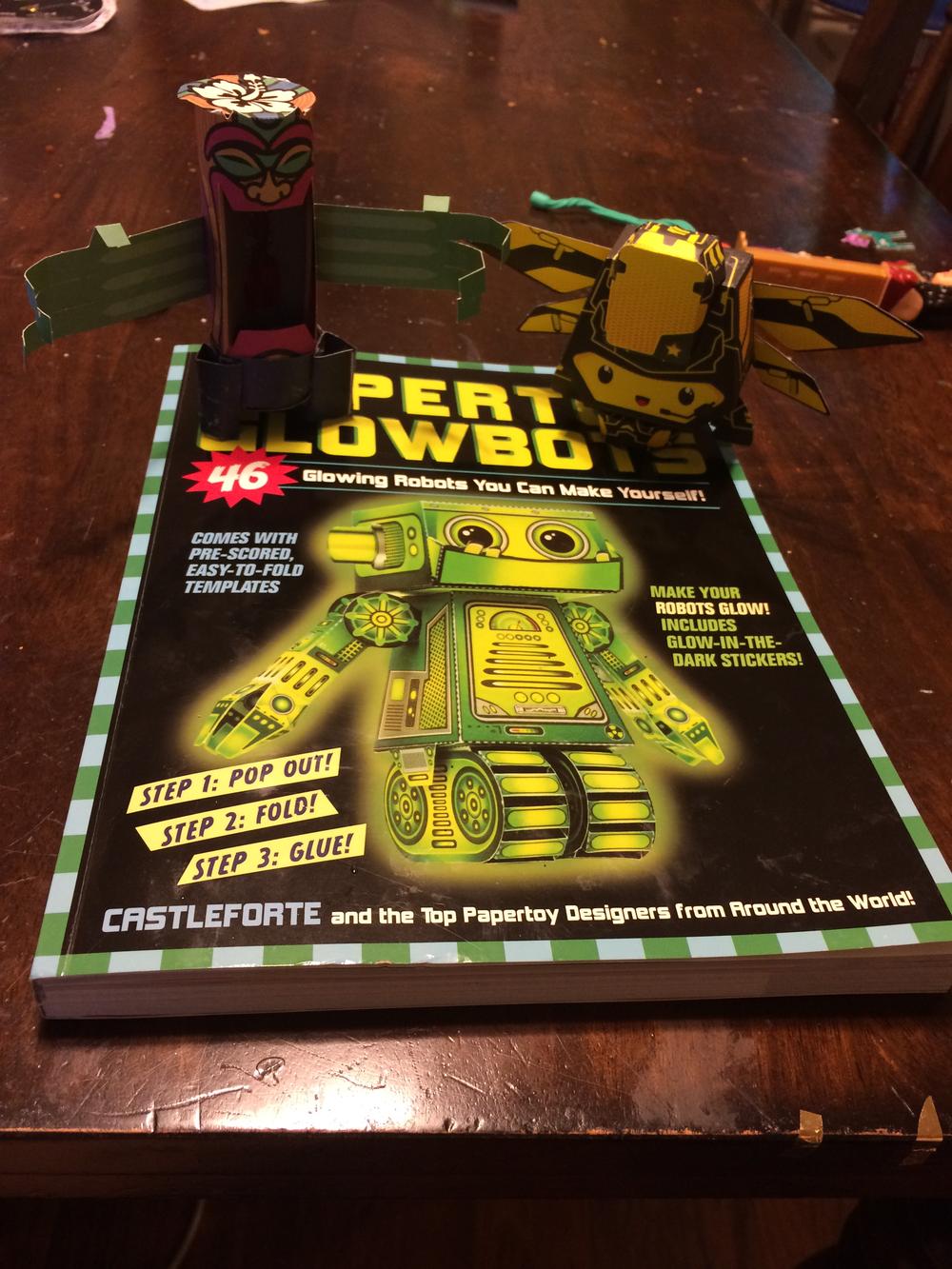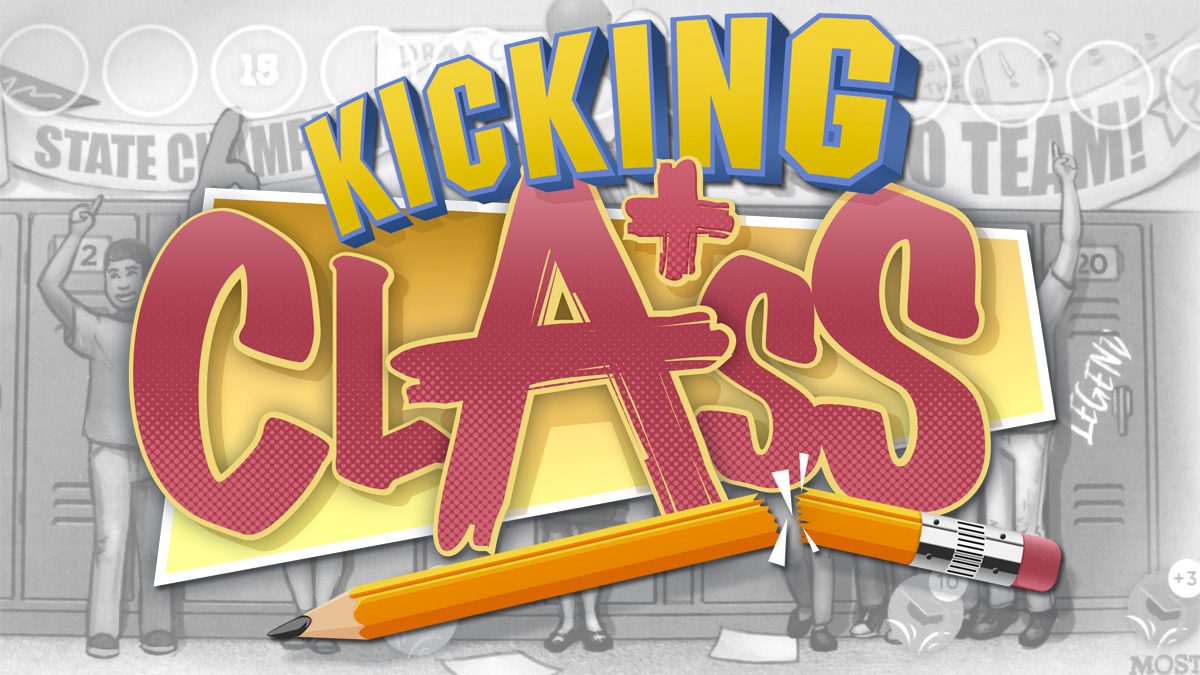
What Is Kicking Class?
Kicking Class is a dice-rolling game for 1 to 4 players aged 10 and up and takes approximately 45 minutes to play. The game is played over four years made up of three trimesters to mimic the U.S. high school experience. The game is currently seeking funding on Kickstarter and a pledge of $39 will get you a copy of the game. The game is set in high school and has appropriately themed action and failure cards which some parents may consider too mature for younger players, but there’s no “Carrie at the prom” moments here, nor any obvious references to drugs, alcohol, or sex.
New to Kickstarter? Check out our crowdfunding primer, and visit our Kickstarter curated page for more projects we love.
Kicking Class Components
Note: My review is based on a prototype copy which may be subject to change before final copies are shipped.
- 1 Gameboard
- 4 Player Character Popularity Markers
- 4 Card Stands
- 40 Skill Dice (10 Blue, 10 Red, 10 Yellow, 10 Black)
- 6 ACT Dice
- 4 Player Character Score Markers
- 1 School Bus Round Marker
- 4 Character Player Boards
- 24 Pencil Tokens in Various Denominations
- 12 Apple Tokens
- 21 Scholarship Point (SP) Tokens in Various Denominations
- 4 Reference Cards
- 80 Class Cards
- 10 Parent Cards
- 38 Action Cards
- 20 Failure Cards
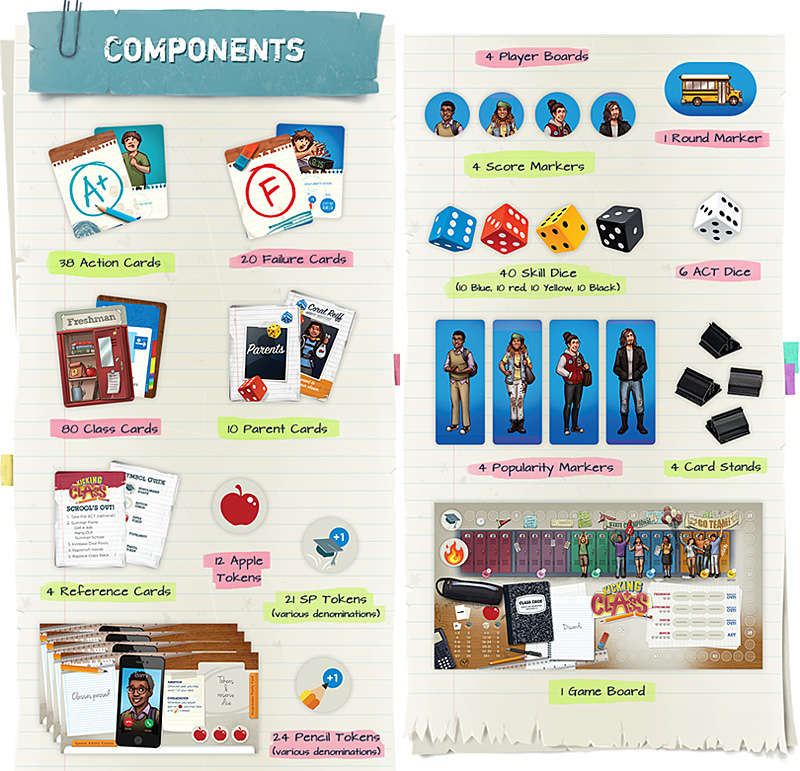
How Do You Play Kicking Class?
Setup
You begin setting up Kicking Class by placing the game board on the table and placing the various tokens and dice in supply piles where everyone can reach them. Shuffle the Action and Failure decks and place them nearby, leaving space for discard piles.
Place the Round Marker on trimester one of the Freshman year on the Round Track. Separate the class cards into the four years—Freshman, Sophomore, Junior, and Senior—and shuffle each deck. Place the Freshman deck in the class space on the board and put the others to the side for now.
Each player chooses a character and places their character board in front of them. Each character has two unique skills which can be used at certain points during the game. The players then place their popularity marker on the fire symbol space at the start of the Popularity Track and their score marker at the start of the Score Track. Shuffle the Parent deck and deal two cards to each player. Players then choose one skill die from the options on each parent card to form their starting dice pool of two. Any remaining parent cards are returned to the box.
Finally, each player takes a reference card and draws three action cards to form their starting hand.
Gameplay
Kicking Class is played over 12 rounds/trimesters divided equally over the four years of high school; there are also summer options to choose from between years. Each trimester is played in three stages.
1. Prepare the Course Schedule
At the start of each trimester, one player draws cards from the class deck equal to the number of players plus one (e.g., four class cards for a three-player game). These are placed face down below the game board and the first three—regardless of the number drawn—are flipped face up. If any players/students are currently suspended, one card less is drawn for each of them.
2. Take Classes
Players take classes in order of their position on the Popularity Track with the most popular player choosing first and ties determined by die roll. Each player chooses a class to take and rolls their dice to try to fulfill the objective on the class card. This may be scoring above or below a specific number, rolling a straight, rolling doubles or triples, or having all the dice show odd or even numbers. If the player’s first roll does not satisfy the objective, they may use action cards, character or parent skills, or other abilities to re-roll some or all their dice.

If the player satisfies the objective, they pass that class and are rewarded with the items on the bottom half of the card. These can be additional action cards, popularity boosts, scholarship point tokens, extra dice to use in later years, or apples and pencils which are used to take the ACT at the end of the year. Extra dice, apples, pencils, and scholarship point tokens are placed on the player’s character board until needed.
Certain special classes award an ongoing special ability if passed. This ability relates to one or more of the class symbols displayed on each class card and can help the player pass future classes by allowing them to re-roll more dice if taking classes bearing that symbol.
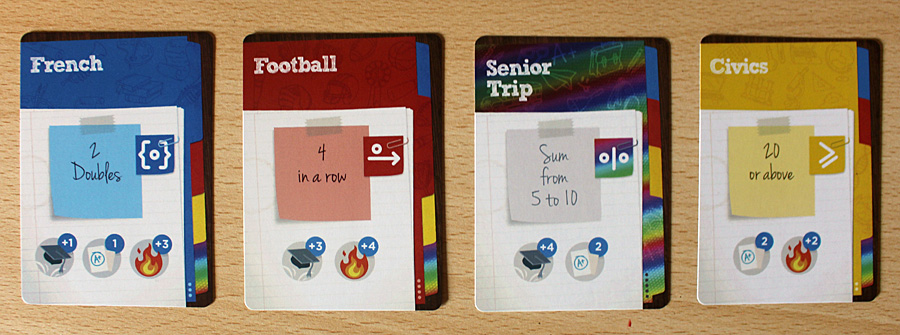
Failing the class forces the player to take a card from the failure deck and follow its instructions. Failure cards can force players to lose popularity or action cards, miss class, or be suspended.
3. End of Trimester
Once each player has attempted to pass a class, that trimester ends. Any remaining class cards in the course schedule are added to the class discard pile and the Round Marker advances. If this ends a school year, the School’s Out phase begins, otherwise, new cards are drawn for the next trimester.
School’s Out! Phase
At the end of each school year except Senior year, the School’s Out phase is played. This phase consists of five stages.
1. Take the ACT (Optional)
Any player who has gained three apple tokens has the option to take the ACT and gain scholarship points.
2. Summer Plans
Players can choose to either Get a Job (take an action card), Hang Out (gain two popularity), or go to Summer School (take an additional class). Summer school is only open to students who passed less than two classes that school year and no failure card is given if the class is failed.
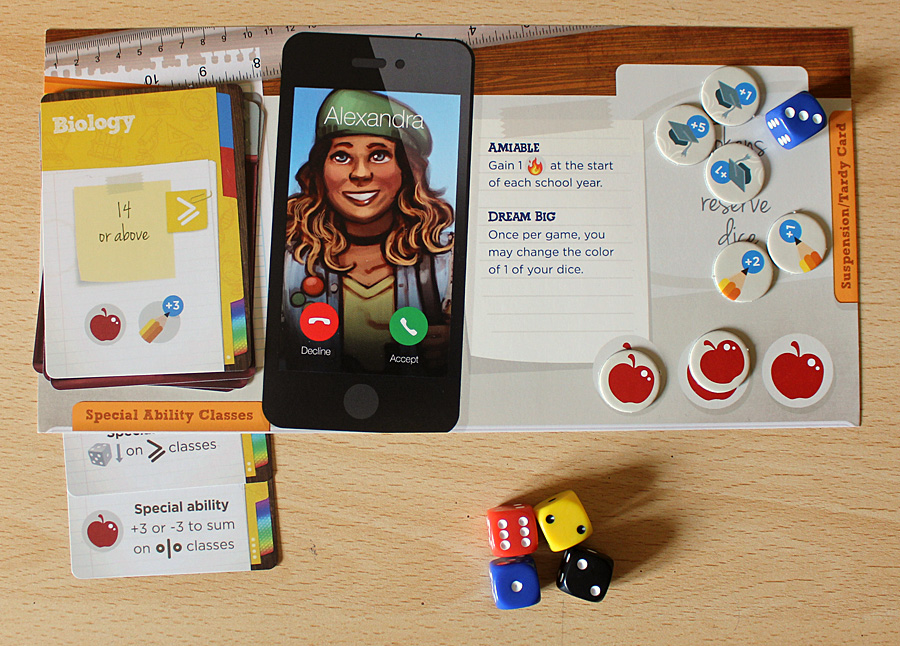
3. Increase Dice Pools
Players add one die to their pool each year, taking their pool size from two dice in Freshman year to five dice in Senior year. They can take a die from the resource area on their character board if they gained any from passing classes or, if they haven’t gained any extra dice that way, they can take a black one from the supply pile.
4. Replenish Hands
Take one action card into their hands (keeping to the hand limit of seven).
5. Replace Class Deck
The current class deck and discard pile are removed from the board and the deck for the next school year is added in its place.
At the end of Senior Year, the School’s Out phase is not played apart from the ACT.
Taking the ACT
Any player who has three apple tokens on their character board at the end of a school year is eligible to take the ACT and it can be taken once per summer so long as the player has the tokens. In order to take the ACT, players hand in their three apples and are handed a two scholarship point token and the six white ACT dice.
Players roll the six ACT dice with the hopes of rolling the highest score possible. The chart below shows how many scholarship points you can earn from your roll total.

If a player has any pencil tokens on their player board, they can use them to influence their ACT score in two different ways. First, they can add the value of their pencil tokens to their dice total, OR they can trade in pencil tokens to re-roll dice. Deciding on how best to use your pencil tokens in order to increase your ACT score is one of the more strategic elements of the game.
Once a player has finished influencing their ACT score with pencils, they move their score token on the score track to show their ACT result. This is the only time the score marker is moved during the game before final scoring.
If a player takes the ACT multiple times, only their best score counts at the end of the game. If they score lower on a subsequent ACT than a previous one, their score marker remains in place; however, if they are able to get a higher score, then their score marker is moved up to reflect this.
Winning
Once the Senior year is over and any ACTs have been taken, it’s time for final scoring. This is broken down into four stages.
1. Best ACT Score
This should already be marked on the score track.
2. Popularity Score
Points are scored based on the players’ final positions on the popularity track. The most popular player is also awarded a bonus of three scholarship points.
3. Passed Classes
Points are awarded based on how many total classes each player passed over the course of the game. These points are calculated using a table similar to the one used to determine the ACT points.
4. SP Tokens
Points on any SP tokens on players’ character boards are added last at face value.
The player with the most scholarship points at the end is the winner. In the case of a tie, there are two tiebreakers—first, go with the player with most classes passed, then the player with the highest popularity.
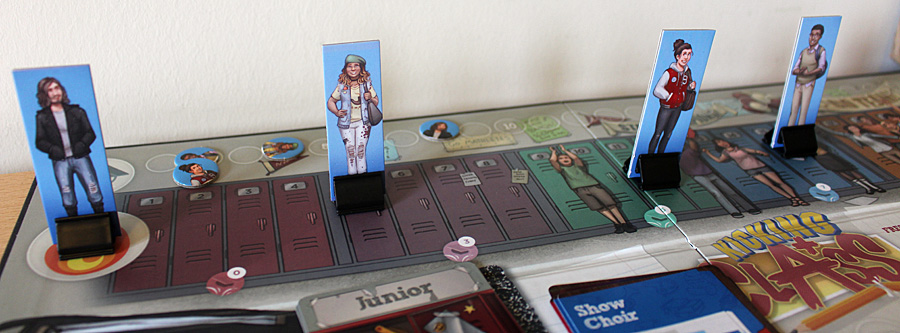
Why Should You Play Kicking Class?
Kicking Class is a fun game with excellent theming. Although it may seem slightly overwhelming on first unboxing, thanks to its multiple sets of colored dice and many piles of tokens, it is easy to pick up and fast to learn. My eight-year-old was able to play with us with only minimal guidance, most of which was required only because he was rushing to choose classes without considering anything except the potential rewards each class had to offer.
One of the aspects we liked least about Kicking Class was how much it relied on luck thanks to the dice rolling mechanism which is used for most elements of the game. On nights where one player was having a case of “the Wheaton Dice Curse” and failing several of their classes, they became stuck in a cycle of being unable to attain the extra dice, action cards, and bonuses that could help them pass, meaning they were increasingly likely to fail subsequent classes. This also felt slightly wrong for the theming because working towards college in real life is generally based more on a solid strategy than random luck. This being said, the dice rolling aspect also leveled the playing field between all the players so my son could play against adults easily.
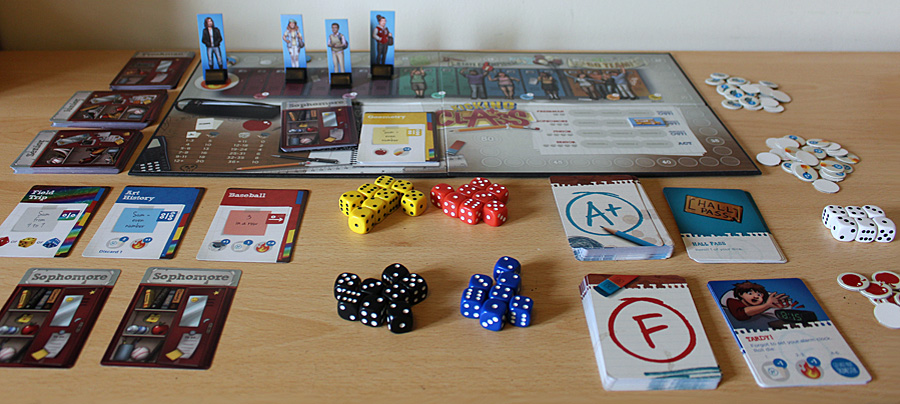
While the game does ultimately rely on luck, there are many things you can do to turn the odds in your favor. Thinking strategically about which classes to pick based on your available dice, special abilities, class abilities, and more will help increase your likelihood of passing and gaining even more bonuses. The Summer phase can also be very useful, taking extra classes can help you build up your resources without risk of failure cards, but opting to hang out and gain popularity can be useful in pushing you to the front of the line for choosing classes—giving you more options to pick from and increasing your chances of finding one you can pass.
The game does allow for a certain amount of backstabbing—it wouldn’t be high school without it after all. Bully cards allow you to force your failures on others or leap ahead of the popular kids to steal a great class from under them. Snitching and cheating are also allowed thanks to certain cards and these can disrupt the game significantly, especially if you’re playing with a particularly vindictive player. Thankfully, “Not in My House” cards can be used to negate some of these effects.
The theming really is the stand out thing with Kicking Class. Nearly all of us have experience of the classic U.S. high school experience—I went to a high school in the UK which was nothing like it but still watched enough U.S. teen shows and movies to have that shared cultural knowledge—and that means players can relate to the experiences in the game. The box art reminded me very much of Riverdale and I could easily see the game being themed to something like this. It would make a perfect gift for fans of teen high school shows (or John Hughes movies for the older generation).
Kicking Class has a lot going for it that made it a fun experience to play. I loved the theming and enjoyed the Yahtzee-style class requirements as I tried to decide if I felt more likely to roll a four-die straight or all even numbers, then stacking up all my resources and abilities to adjust those pesky dice that weren’t rolling the way I needed them. Of course, nothing felt better than getting the roll I needed on the first try! Kicking Class is a funny and entertaining game that will transport you back to your high school days without the acne and awkwardness that none of us miss.
If you’d like to play Kicking Class and take yourself back to high school for an hour, funding is now open on Kickstarter.

